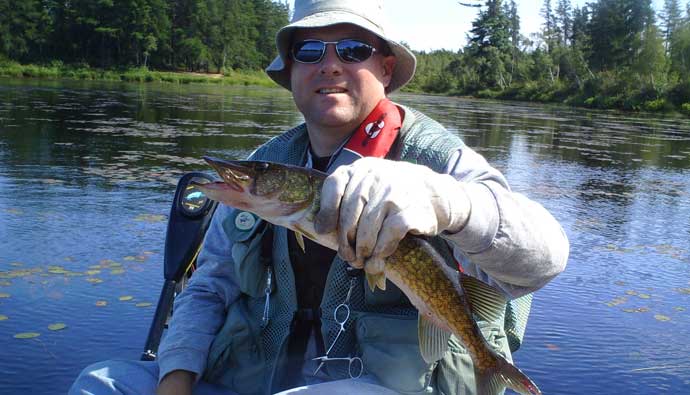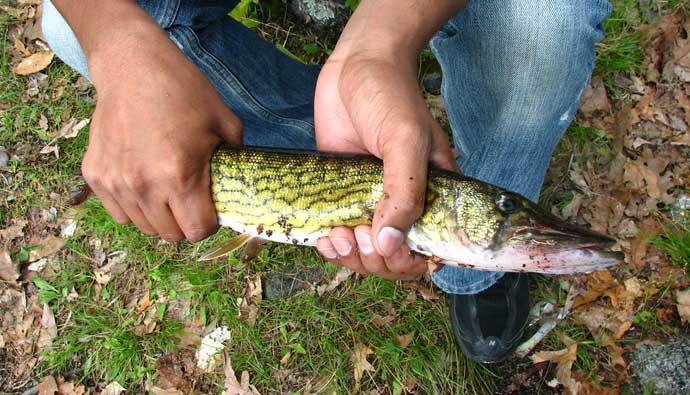Chain Pickerel are some of the best fighting and tastiest freshwater fish, that is, if you can stand the teeth!

These fish can be found in most creeks and bodies of water in eastern North America from Miami all the way up to the southern reaches of Canada. They are often referred to as the “Southern Pike”, “Grass Pike”, and “Jack Fish.”
Overview
Pike vs. Pickerel
These fish physically resemble Northern Pike except for having a few small differences in coloration. They can be distinguished by the dark chain-like pattern on their green sides as well as a dark black stripe running vertically on their heads below and above their eyes.
They usually act similarly to Northern Pike, referring to their actions and hunting methods. These fish rarely get above twenty-four inches as well as weighing three pounds.
World Record
The all-tackle record Chain Pickerel was 24.4 inches long.
Chair Pickerel Facts
| Common Name | Chain Pickerel |
| Scientific Name (Genus and Species) | Esox niger |
| Family | Esocidae |
| Identifying Characteristics | Light Green with dark chain-shaped markings along the body. Black stripe running vertically along with both eyes |
| Habitat | US and Canada in ponds, creeks, and lakes, mostly around grass and mats along the bank. |
| Depth Range | Anywhere from one foot to thirty feet, depending on weather and water temp. |
| Fishing Information | Chain Pickerel usually target small minnow-type baits. |
| Size | These fish usually range from 12 inches up to 24 inches |
Diet
Chain Pickerel are predatory fish, which means they mainly feast on small fish, that is, until they get large enough to prey and much larger fish by ambushing them and trapping them with their teeth.
Jack fish are also known to feast on mice, frogs, worms, and pretty much anything else that happens to cross their path.
These fish are even known to leap out of the air to catch flying insects as well as dangling fishing lures!
Pickerel Fishing
Chain Pickerel are often fairly easy to catch and tend to stay in grass and heavy cover. This way, they are hidden and ready to ambush any unsuspecting fish that happens to pass by.
Usually, I tend to stick to power fishing when targeting pickerel.

Tackle
The baits I throw are typically crankbaits, rattletraps, chatter baits, and topwater lures.
Pickerel are usually reactive when they are feeding, unlike bass and crappie, which go out and hunt for prey.
Freshwater jack fish will sit and wait for something to swim by, giving an angler the opportunity to quickly retrieve bait by a patch of grass and cause the pickerel to quickly react to the presentation and strike.
Pickerel is a thousand times faster than bass and crappie. Their long slender bodies help them glide through the water and catch up to most any retrieve.
Lures
Small flashy lures such as Rooster Tails and spoons work wonders on these fish as they imitate small minnows, which are the main forage for Pickerel.
When it comes to topwater lures, pretty much anything will catch a pickerel as they generally get irritated easily.
Enticing strikes from chain pickerel when using topwater plugs is simply creating a large amount of water dispersion, noise, and action then, followed by long pauses, which usually create massive blow-ups with the fish flying through the air with the lure in their mouths!
How to Clean Pickerel Fish
Can You Eat Pickerel?
Freshwater jackfish are good fish to eat. Their meat is lean and flaky. Although the meat is good, these fish are bony.
They can be difficult to clean without getting bones into the filets.

- Cut straight down behind the top of the backbone, making sure not to cut through the backbone.
- Turn your fillet knife and run your blade down along the backbone towards the tail until you nearly reach the dorsal fin. You may feel your knife bumping the tops of the Y bones. Turn your blade up and separate your first boneless filet
- With your finger, find the row of Y bones that run parallel on each side of the backbone. Using the tip of your knife, gently cut down about half of an inch on the outside of the Y bones.
- Then using your fingers to gently pull back the fillet while running your knife along the rib cage, free the fillet from all of those bones.
- Make a cut perpendicular in front of the fish vent. Cut away the belly fat, and you have your second boneless fillet.
- Repeat on the other side, and you have your third boneless fillet.
- Next, cut the meat on each side of the tail just below the vent. There are no Y bones in the tail meat! This will yield two more boneless fillets for a total of five fillets.
- Next, remove all the skin from your fillets with your knife.
There is a line of cartilage down the middle of the first fillet that was cut off from the top of the fish. You may want to remove that, which would then leave you with six boneless fillets.
How to Cook Chain Pickerel

Easy Fried Fish Fillets
Ingredients
1 pound fish fillets
Oil for deep frying
1/2 cup flour
Dash salt (or to taste)
Dash pepper (or to taste)
1/4 teaspoon paprika
Chain Pickerel Recipe
- Pour 1 inch of oil into the skillet; heat to 375 F.
- Combine flour, salt, pepper, and paprika, and mix them together.
- Dip fish fillets into the flour mixture.
- Working in batches, fry fish for about 5 minutes on each side; remove to a platter.
- Serve hot with tartar sauce or homemade remoulade sauce.
FAQs
Q: Where are chain pickerel found?
A: Chain pickerel can be found in almost any freshwater lake or creek. Because of the low predator threat, they easily thrive.
Q: Do chain pickerel bite?
A: Yes. They have sharp teeth that it is a good idea to be aware of before removing hooks or lures.
Q: Do you need special tackle to fish for chain pickerel?
A: Not especially. It is a good idea to use a leader if you are going specifically for chain pickerel. They do have sharp teeth that can slice right through the line.
Q: Are chain pickerel an invasive species?
A: There are some that agree chain pickerel are an invasive species as they have a low predatory threat to their numbers in the areas they live in. However, this is still up for discussion.
Q: Are chain pickerel a hard-fighting fish?
A: They can be. They are most definitely fun to catch.
Insider Advice

It is safe to say that Chain Pickerel can be some of the trickiest fish you can go after. They are some of the best-eating fish you can get your hands on.
I enjoy catching them as they are something different and tend to fight much harder and longer than most bass.
Go out and look for the swampiest grassiest creek or lake and throw some spinners out. You never know what you might pull up!




 Facebook
Facebook YouTube
YouTube








